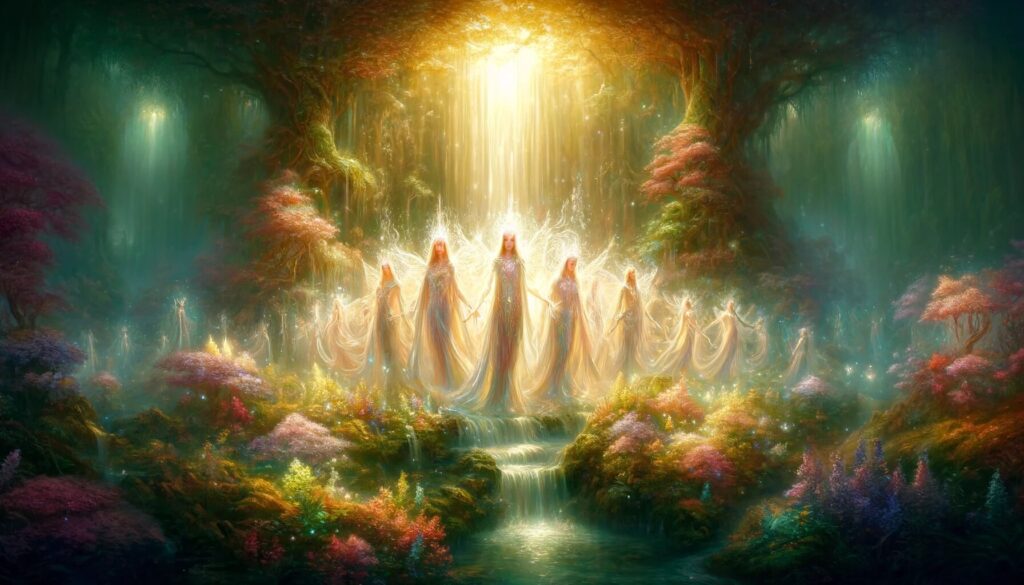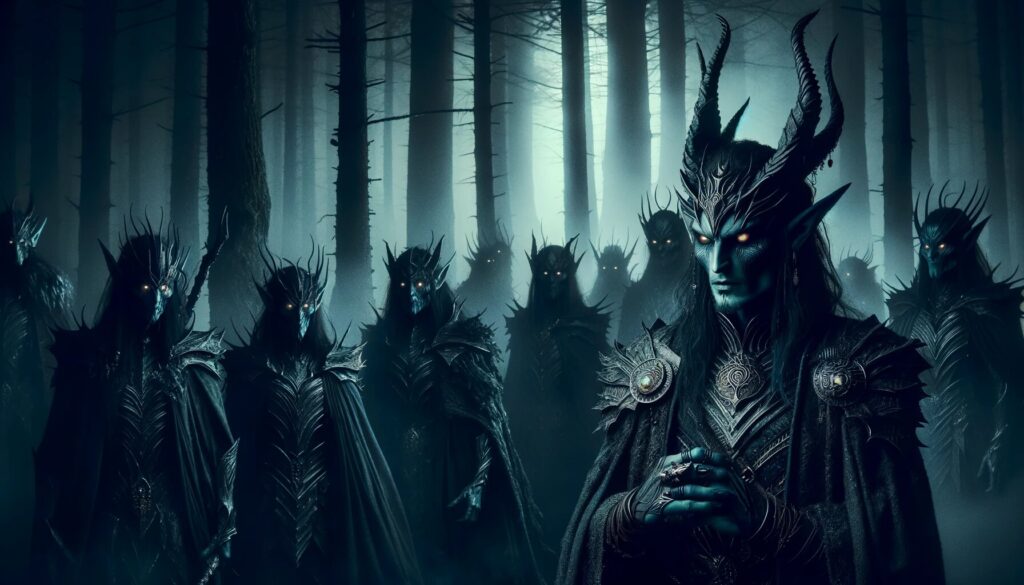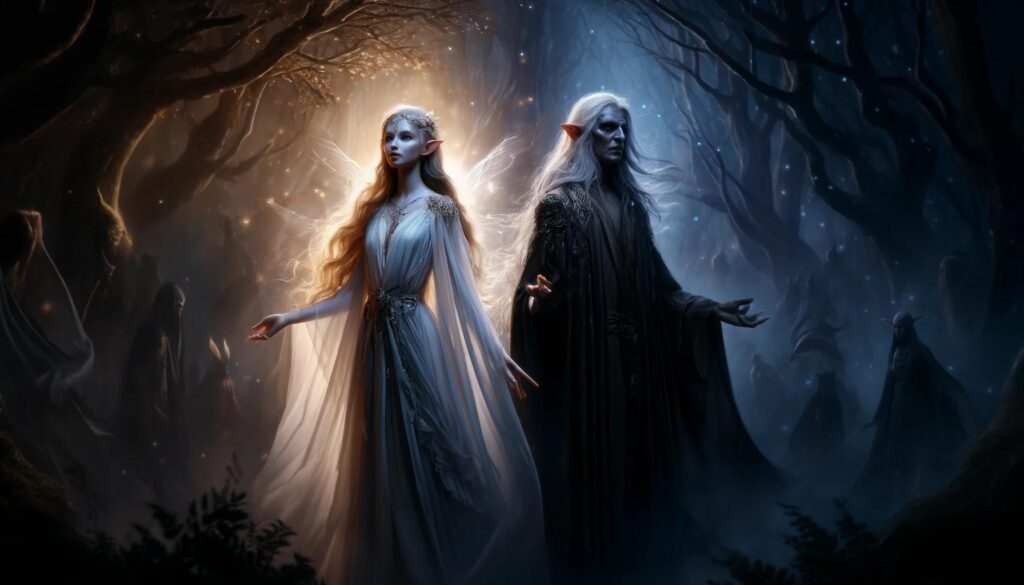Alfheim, Creatures in Norse mythology, Elves, Nidavellir (Svartalfheim), Norse Mythology
Between Light and Shadow: The Enigma of Light and Dark Elves
Delve into the fascinating world of light and dark elves in Norse mythology. Explore the enigmatic nature of these mythical beings and their contrasting realms of light and shadow. Learn about the rich lore and symbolism associated with light and dark elves and discover the role they play in Norse mythology.
What Are Light and Dark Elves?
In Norse mythology, light and dark elves are ethereal beings that exist in contrasting realms. They are prominent figures in Norse mythological texts, such as the Prose Edda, and possess intriguing origins, captivating myths, and significant roles in the Norse pantheon.
Understanding the Origins of Light and Dark Elves
The origins of light and dark elves can be traced back to Norse mythology. According to ancient texts, they are said to have originated from specific corners of the cosmos, such as Alfheim for light elves and Svartalfheim for dark elves, symbolizing the duality found in the natural world. Light elves, known as Ljósálfar, inhabit Álfheimr, a radiant beauty and harmony realm. On the other hand, dark elves, or Dökkálfar, reside in Svartálfaheimr, a subterranean realm associated with shadows and mystery.
Depictions of Light and Dark Elves in Mythology
Throughout mythological texts, including the Prose Edda, light and dark elves, or angels of light and black elves, are depicted in various ways. Light elves are often described as luminous and fair, possessing an otherworldly beauty. They are associated with magic, wisdom, and an affinity for nature. In contrast, dark elves are described as shadowy and mysterious, dwelling underground and having a closer connection to the realms of darkness and enchantment.
The Role of Light and Dark Elves in Norse Mythology
Light and dark elves play significant roles in Norse mythology, interacting with gods, humans, and other mythological creatures. They are known for their unique abilities and talents. Light elves are believed to possess healing powers, exceptional craftsmanship, and shape-shift ability. Dark elves, on the other hand, are renowned for their mastery of illusions, dark magic, and stealth.
Powers and Abilities of Light and Dark Elves
Light and dark elves, beings of ethereal lore in Norse mythology, possess a range of supernatural powers and abilities that set them apart. Let us delve into the magical abilities of light elves and the unique powers possessed by dark elves, uncovering the mystical world they inhabit.
Exploring the Magical Abilities of Light Elves
Light elves are known for their magical prowess and abilities. They possess an innate affinity for healing, using their mystical powers to mend wounds and restore vitality. These benevolent creatures can bring comfort and aid to those in need, harnessing their restorative energies to promote well-being.
In addition to their healing abilities, light elves have a remarkable aptitude for shape-shifting. They can assume different forms, seamlessly blending into their surroundings or taking on the appearance of other beings. This skill grants them a heightened sense of adaptability and allows them to navigate various realms undetected.

Enchantment is yet another magical ability that light elves possess. With a mere touch or a whispered incantation, they can infuse objects with ethereal energy, endowing them with mystical properties, a notion deeply rooted in the lore of Alfheim and the domains they inhabit. These enchanted items can bestow blessings, protect from harm, or exhibit extraordinary qualities.
The Unique Powers Possessed by Dark Elves
Dark elves, on the other hand, possess a different set of supernatural powers that reflect their mysterious nature. One of their distinctive abilities lies in their mastery of illusions. Dark elves can create intricate and captivating illusions, often using this power to confuse and deceive their adversaries. Within their realm of shadows, their illusions become indistinguishable from reality, leaving others vulnerable to their cunning tactics.
Dark elves also wield potent dark magic, tapping into sinister forces that grant them immense power. They can harness this magic to cast spells of darkness, control shadows, and manipulate the very fabric of reality. Their command over dark magic sets them apart as formidable adversaries in the world of old Norse, capable of unleashing chaos and wreaking havoc at will.
Stealth is a defining attribute of dark elves, enabling them to move undetected through the shadows. They possess an uncanny ability to blend into the darkness, becoming nearly invisible to the naked eye. This skill gives them an advantage in hunting, tracking, and ambushing their targets, making them formidable assassins and spies.
Together, the magical abilities of light and dark elves create a vibrant tapestry of supernatural powers in Norse mythology. These enigmatic beings continue to captivate our imagination, their powers serving as a testament to the rich and profound lore that surrounds them.
The Influence of Light and Dark Elves in Norse Mythology
In Norse mythology, light and dark elves hold a significant presence, playing distinct and interconnected roles. These ethereal beings are depicted in various mythological texts, each with their own characteristics and symbolism.
Comparing Light Elves and Dark Elves in Norse Mythological Texts
When examining Norse mythological texts, a comparison between light elves and dark elves reveals contrasting qualities. Light elves, also known as Ljósálfar, are associated with celestial realms and are often depicted as beings of radiance and beauty. They possess a strong connection to light and are known for their enchanting abilities and ethereal grace.
In contrast, dark elves or Dökkálfar dwell in Svartálfheim, the realm of darkness. These enigmatic creatures are often portrayed as mysterious and secretive. They possess unique powers and are skilled in illusions, dark magic, and invisibility.
The Connection Between Light/Dark Elves and Other Mythological Creatures
Light and dark elves are not isolated within the Norse mythological pantheon. They have a deep connection with other mythical creatures, such as dwarves and gods. Light elves are often associated with the likes of Freyr, the god of fertility, and are described as guardians of nature. They also share a kinship with the Vanir, a group of gods associated with fertility, prosperity, and nature.
Dark elves, on the other hand, are intricately linked to dwarves, and together, they are often referred to as svartálfar in Old Norse texts. There are instances where dwarves and dark elves are referred to interchangeably, blurring the line between the two. This connection further emphasizes the complex nature of light and dark elves in Norse mythology.
Symbolism and Connotations Associated with Light and Dark Elves
Light and dark elves bear deep symbolism and connotations in Norse mythology, reflecting the complex nature of these beings as depicted in ancient texts such as the Prose Edda. Light elves symbolize purity, enlightenment, and harmony with nature. They represent the ethereal and beneficent aspects of existence, bringing light and joy to their surroundings.
Conversely, dark elves, or svartálfar as known in old Norse, carry darker connotations, often associated with secrecy, danger, and the unknown. They represent the shadowy and mysterious aspects of existence, serving as a reminder of the duality and complexity of the mythological world.
Therefore, the influence of light and dark elves in Norse mythology is profound and multifaceted. Their depictions in mythological texts, connections with other creatures, and symbolic connotations all contribute to their mystique and significance within the rich tapestry of Norse folklore.
Comparative Analysis: Light Elves vs. Dark Elves
When exploring the enchanting realm of Norse mythology, one cannot overlook the captivating figures of light elves and dark elves, these beings that Tolkien also found inspiring for his legendarium. In this section, we will delve into a comparative analysis of these mythical beings, examining their cultural representations across various mythologies and folklore.
Examining the Cultural Representation of Light Elves
Light elves, known for their ethereal beauty and radiant presence, have captivated the imaginations of storytellers throughout history. They embody the angels of light. In Norse mythology, these beings are often depicted as benevolent and virtuous, embodying the essence of light, purity, and goodness. From their portrayal in ancient Norse mythological texts to their appearances in modern folklore, light elves are revered as beings of enlightenment and grace.
Contrasting Traits Between Light and Dark Elves
While light elves embody luminosity and benevolence, dwelling in Alfheim as depicted in old Norse texts, dark elves exist on the opposite end of the spectrum, in realms shrouded in mystery. Often depicted as mysterious and enigmatic, dark elves possess a contrasting allure. In Norse mythology, they are associated with underground realms and possess unique powers, such as mastery of illusions and dark magic. These contrasting traits between light and dark elves create a dichotomy that adds depth and intrigue to their mythological roles.

Exploring the Ambiguous Nature of Light and Dark Elves
One of the most intriguing aspects of light and dark elves, as chronicled in works like the Prose Edda, is their ambiguous nature. These mythical beings, including light and dark elves, dance along the blurred lines of good and evil, light and shadow. As cultural representations have evolved over time, interpretations of light and dark elves have varied, resulting in a certain level of ambiguity. This ambiguity adds an enigmatic quality to light and dark elves, making them symbols of duality and complexity within Norse mythology.
Summary
Throughout Norse mythology, light and dark elves have captivated the imagination with their ethereal lore. These mythological beings originate from ancient texts and are known for their contrasting realms of light and shadow. Light elves possess magical abilities such as healing and shape-shifting, while dark elves are masters of illusions and dark magic.
In Norse mythology, light elves and dark elves play significant roles, interacting with gods, humans, and other mythological creatures. Their connection to dwarves and the symbolism associated with them adds further depth to their narratives. Light elves are often depicted with positive connotations, representing purity and spirituality, while dark elves embody the ambiguous nature of good and evil.
As cultural representations of light and dark elves vary across mythologies and folklore, their distinct traits and abilities are highlighted. Nevertheless, the allure of these mythological beings lies in their enigmatic nature, leaving room for interpretation and sparking intrigue, much like the captivating narratives found in old Norse and Tolkien’s works. In Norse folklore and storytelling, light and dark elves continue to shape the narrative landscape, adding richness and depth to this captivating realm of ethereal lore, a concept that has also influenced the works of Tolkien.

